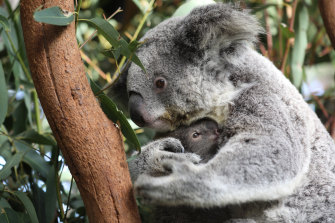Government commits $50 million to save koalas
Koala conservation funding is set to be boosted with a $50 million commitment from the federal government for habitat restoration, population monitoring and research into animal health.
The iconic species is in big trouble due to habitat loss from land clearing for farming and urban development. It is listed as vulnerable in NSW, ACT and Queensland, meaning koalas face a high risk of extinction in the medium term.
The federal government has committed an additional $50 million for Koala conservtion.
It is estimated as many as one-third of NSW koalas – about 10,000 animals – perished in the 2019-20 Black Summer bushfires and the preceding drought.
The $50 million in funding is set to be announced at Australia Zoo on the Sunshine Coast, Queensland, and is pledged to come over the next four years. It is additional to $24 million announced previously by the government for koalas since 2019.
Prime Minister Scott Morrison said the investment would “enhance the protection of koalas by restoring koala habitat, improving our understanding of koala populations, supporting training in koala treatment and care, and strengthening research into koala health outcomes”.
As well as other investments in koala research and treatment for injured animals, the package includes $20 million in grants to state governments, environment groups and industry for habitat restoration projects, and $10 million for community initiatives.
It also includes $10 million for the government’s koala census, involving the CSIRO and citizen science to establish baseline population data that it says could identify critical areas for habitat protection and act as a backstop against harmful development being approved by state governments.
Environment Minister Sussan Ley said current funding is focused on eight habitat restoration projects on the eastern seaboard, as well as scientific research into diseases that hurt the species and treatment for injured koalas.
“Research is under way to reduce the disease threat facing many animals including a world-first genome sequencing program to determine the genetic strength of populations and how unique DNA variants can provide resistance to diseases such as chlamydia,” Ms Ley said.
“More than 3200 vets and veterinary nurses have received specialist bushfire trauma training, with new programs to be funded as we continue to work with major zoos.”
Environmental groups are critical of the rate and scale of land clearing in koala habitat, arguing it continues at dangerous levels despite habitat loss being recognised as one of the two biggest extinction threats for native animals, along with feral predators.
Data released on December 30 by the Queensland government showed in that state alone more than 650,000 hectares of woody vegetation was completely or partially cleared in 2018-19, which appears to be a significant increase on the roughly 400,000 hectares cleared in the previous 12 months, although satellite technology used to identify clearing is constantly improving, making direct comparisons complicated.
“Preliminary estimates indicate 84 per cent of the area of land cleared comprised regrowing trees that were older than 15 years of age, which could be 10 metres high, and provide important habitat for koalas and other threatened wildlife,” said Dr Stuart Blanch, WWF Australia conservation scientist said in December.
An analysis of government development approval registers by the World Wildlife Fund found that between 2010 and 2018, 43,113 hectares of known koala habitat was cleared, excluding logging operations.
Most Viewed in Politics
From our partners
Source: Read Full Article
